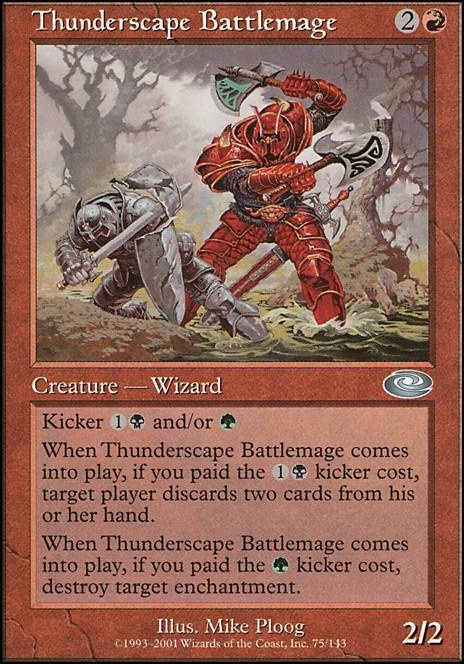Big boiz (18)
- 1x Experiment One
- 1x Nested Shambler
- 1x Nyxborn Hydra
- 1x Gluttonous Slug
- 1x Horned Kavu
- 1x Eldrazi Repurposer
- 1x Elephant Guide
- 1x Jewel Thief
- 1x Chain Devil
- 1x Crimson Fleet Commodore
- 1x Wickerbough Elder
- 1x Writhing Chrysalis
- 1x Avenging Hunter
- 1x Gray Merchant of Asphodel
- 1x Underdark Explorer
- 1x Generous Ent
- 1x Oliphaunt
- 1x Troll of Khazad-dum
Increment (8)
- 1x Experiment One
- 1x Sadistic Glee
- 1x Eternal Thirst
- 1x Gluttonous Slug
- 1x Stirring Bard
- 1x Vicious Battlerager
- 1x Avenging Hunter
- 1x Underdark Explorer
Fixing (5)
Filter (4)
Sweep (3)
Haste (2)
Tutor (1)
Removal (13)
- 1x Lightning Bolt
- 1x Pick Your Poison
- 1x Accursed Marauder
- 1x Cleansing Wildfire
- 1x Extract a Confession
- 1x Return to Nature
- 1x Terminate
- 1x Parasitic Impetus
- 1x Shiny Impetus
- 1x Chain Devil
- 1x Snuff Out
- 1x Wickerbough Elder
- 1x Wrecking Ball
Mana (10)
- 1x Arbor Elf
- 1x Springleaf Drum
- 1x Utopia Sprawl
- 1x Wild Growth
- 1x Sakura-Tribe Elder
- 1x Viridian Emissary
- 1x Cultivate
- 1x Eldrazi Repurposer
- 1x Llanowar Visionary
- 1x Writhing Chrysalis
Buff (6)
Land (24)
Sustain (4)
Hate (2)
Commander (1)
Land tapped (12)
- 1x Black Dragon Gate
- 1x Bojuka Bog
- 1x Darkmoss Bridge
- 1x Drossforge Bridge
- 1x Golgari Rot Farm
- 1x Highland Forest
- 1x Manor Gate
- 1x Rakdos Carnarium
- 1x Slagwoods Bridge
- 1x Thriving Grove
- 1x Thriving Moor
- 1x Woodland Chasm
Draw (7)
- 1x Night's Whisper
- 1x Snake Umbra
- 1x Unseal the Necropolis
- 1x Yavimaya Elder
- 1x Crimson Fleet Commodore
- 1x Syphon Mind
- 1x Thorn of the Black Rose
Recycle (5)
- 1x Urborg Repossession
- 1x Evolution Witness
- 1x Unseal the Necropolis
- 1x Ardent Elementalist
- 1x Dread Return
Trix (4)
Sideboard
Big boiz (11)
- 1x Young Wolf
- 1x Basking Broodscale
- 1x Conclave Naturalists
- 1x Entourage of Trest
- 1x Panicked Altisaur
- 1x Sporemound
- 1x Staunch Throneguard
- 1x Rapacious One
- 1x Topiary Panther
- 1x Annoyed Altisaur
- 1x Ulamog's Crusher
Filter (3)
Sustain (2)
Buff (1)
Hate (1)
Other (1)
Sweep (1)
Removal (10)
- 1x Nature's Claim
- 1x Abrade
- 1x Cast into the Fire
- 1x Go for the Throat
- 1x Lignify
- 1x Demon's Disciple
- 1x Fleshbag Marauder
- 1x Stinkweed Imp
- 1x Smashing Success
- 1x Conclave Naturalists
Draw (5)
- 1x Gibbering Barricade
- 1x Bushmeat Poacher
- 1x Entourage of Trest
- 1x Staunch Throneguard
- 1x First-Sphere Gargantua
Tutor (2)
Recycle (1)
Land (7)
- 1x Great Furnace
- 1x Haunted Fengraf
- 1x Hickory Woodlot
- 1x Jund Panorama
- 1x Peat Bog
- 1x Tree of Tales
- 1x Vault of Whispers
Mana (6)
- 1x Nature's Lore
- 1x Three Visits
- 1x Thunderscape Familiar
- 1x Firewild Borderpost
- 1x Veinfire Borderpost
- 1x Mwonvuli Acid-Moss
Increment (3)
Fixing (1)
Maybeboard
Big boiz (11)
- 1x Bayou Groff
- 1x Bannerhide Krushok
- 1x Gouged Zealot
- 1x Penumbra Spider
- 1x Sarulf's Packmate
- 1x Trumpeting Herd
- 1x Owlbear
- 1x Silumgar Scavenger
- 1x Hooting Mandrills
- 1x Krosan Tusker
Recycle (5)
Filter (4)
Draw (3)
Haste (1)
Hate (1)
Mana (10)
- 1x Dark Ritual
- 1x Fertile Ground
- 1x Goblin Anarchomancer
- 1x Nest Invader
- 1x Rime Tender
- 1x Sculptor of Winter
- 1x Kodama's Reach
- 1x Overgrowth
- 1x Druid of the Emerald Grove
- 1x Skyshroud Claim
Land tapped (6)
- 1x Evolving Wilds
- 1x Gruul Turf
- 1x Mortuary Mire
- 1x Riveteers Overlook
- 1x Sulfurous Mire
- 1x Terramorphic Expanse
Sustain (4)
Trix (3)
Other (1)
Increment (9)
- 1x Predatory Hunger
- 1x Basilica Screecher
- 1x Impact Tremors
- 1x Trespasser's Curse
- 1x Crawling Infestation
- 1x Witty Roastmaster
- 1x Yuan-Ti Fang-Blade
- 1x Silumgar Scavenger
- 1x Zombie Ogre
Removal (8)
- 1x Innocent Blood
- 1x Skred
- 1x Tragic Slip
- 1x Cast Down
- 1x Deadly Recluse
- 1x Tithing Blade Flip
- 1x Oubliette
- 1x Mold Shambler
Buff (3)
Fixing (2)
Sweep (1)
Suggestions
Updates Add
Comments
Attention! Complete Comment Tutorial! This annoying message will go away once you do!
Important! Formatting tips — Comment Tutorial — markdown syntax
Please login to comment
92% Casual
Competitive
| Date added | 1 year |
| Last updated | 6 days |
| Legality | This deck is Pauper EDH legal. |
| Cards | 100 |
| Avg. CMC | 2.69 |
| Tokens | Dungeon: Undercity, Eldrazi Spawn 0/1 C, Elephant 3/3 G, Food, Saproling 1/1 G, Skeleton 4/1 B, Squirrel 1/1 G, The Initiative, The Monarch, Treasure |
| Folders | PDH |
| Votes | |
| Ignored suggestions | |
| Shared with | |
| Views |

